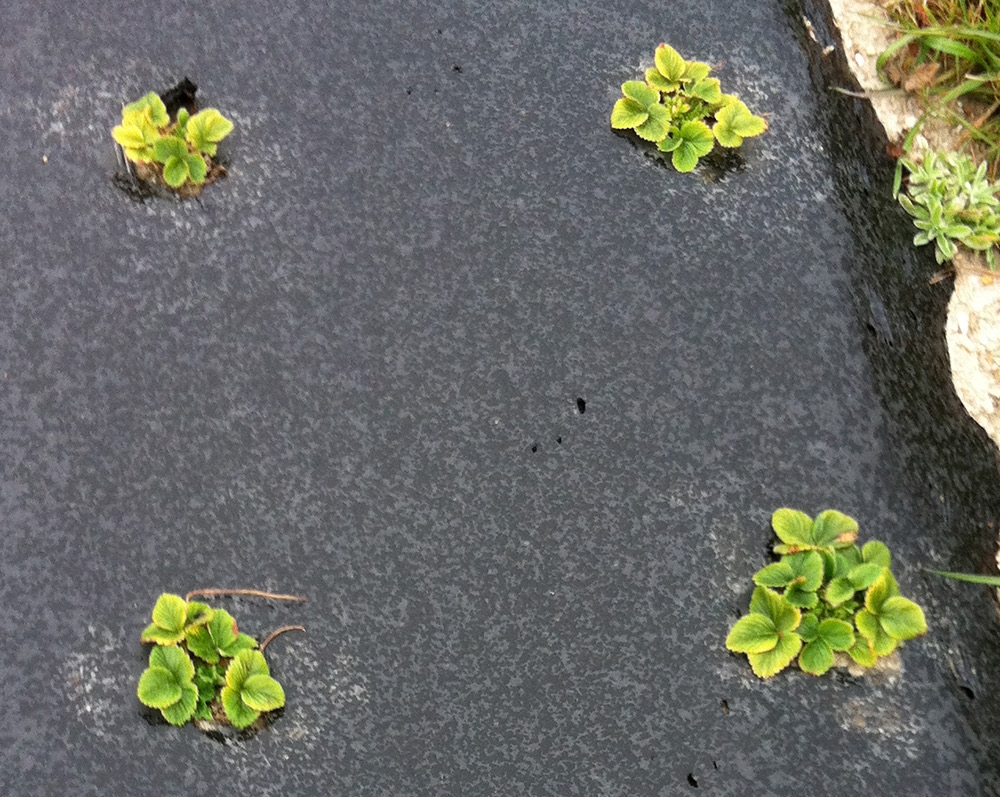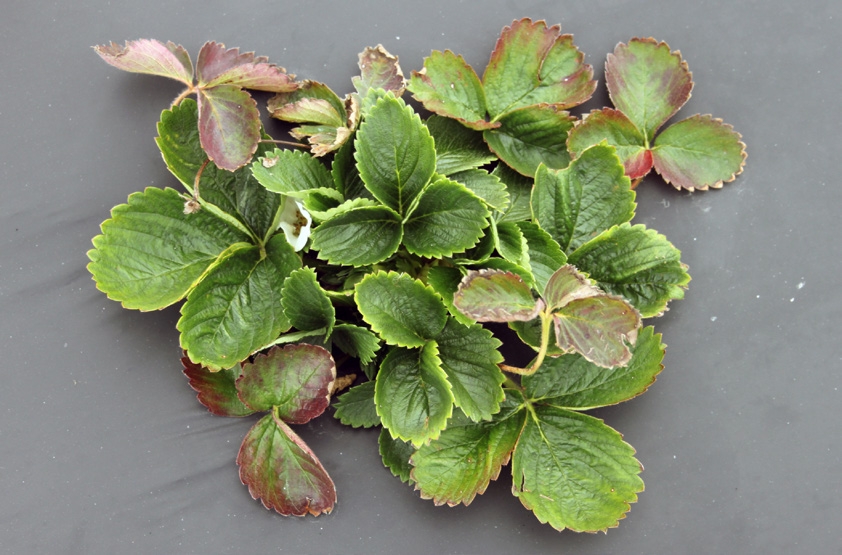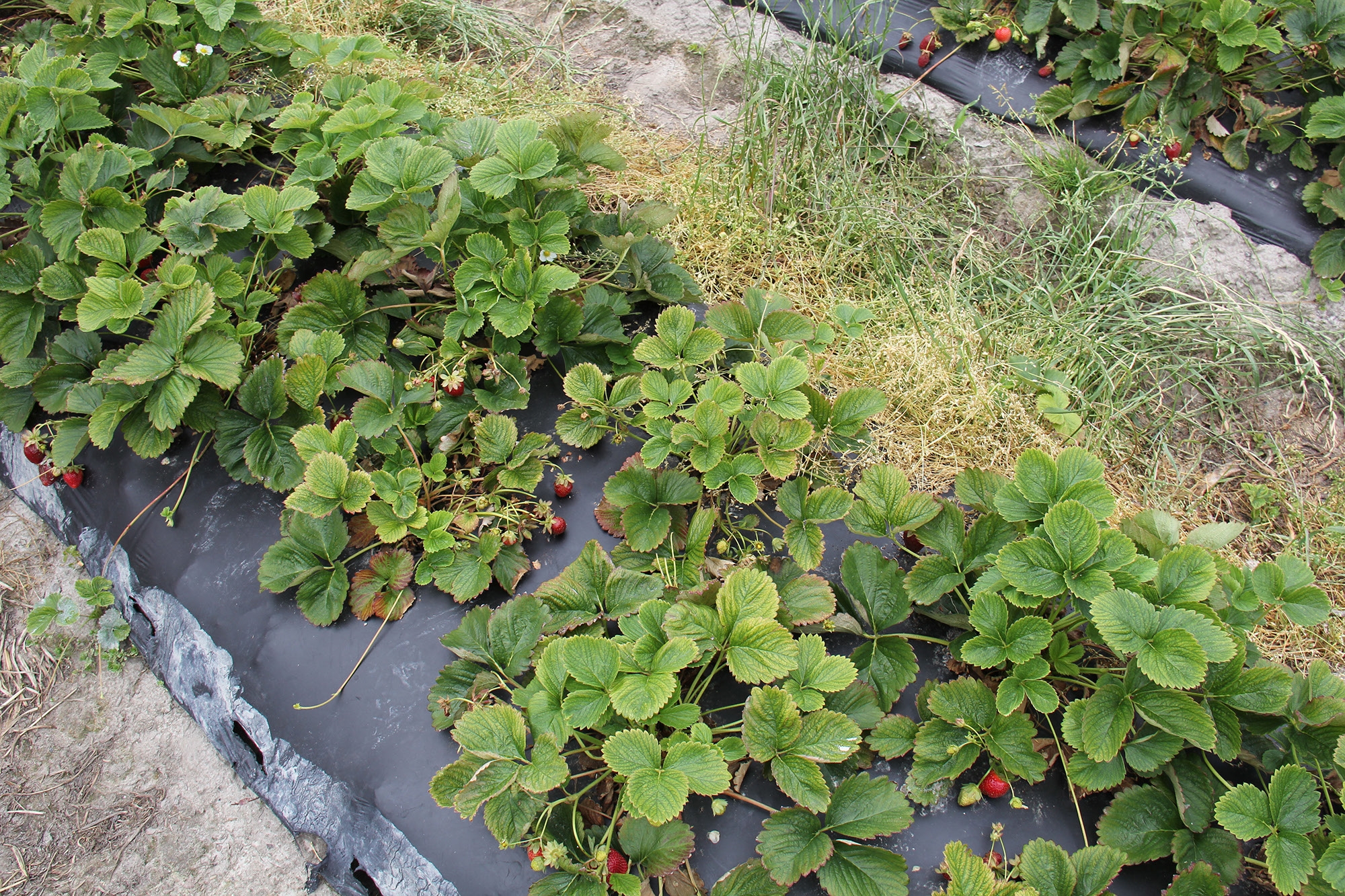Mixed Infection of Strawberry Mottle Virus and Strawberry Mild Yellow Edge Virus in the Southeastern United States
ID
HORT 268P (SPES-488P)
EXPERT REVIEWED

Introduction
More than 30 viruses and phytoplasmas are known to affect the genus Fragaria. Multiple viruses infecting strawberries (Fragaria xananassa Duch.) can severely affect plant productivity and reduce fruit quality. Complexes of viruses or mixed virus infections in strawberries in an annual production system were not identified in the southeastern United States prior to fall 2012. Within four to six weeks of transplanting strawberries in the fall of 2012 for annual plasticulture production, many growers in Virginia noticed some loss of crop stand and plants that exhibited yellowing along the leaf margins of several younger leaves (as seen in figs. 1 and 2). In some plants, these symptoms progressed to marginal necrosis.


The symptoms were seen either spread throughout fields or in certain parts of a field. Roots and crowns of plants showed no indication of fungal infection. On-site diagnosis based on visual symptoms was difficult, and several possibilities — including high salt levels in soil, low and irregular distribution of soil moisture, improper soil pH, herbicide use, and boron micronutrient deficiency — were considered. Over the next few days it became known that growers in several other southeastern states, including North Carolina, South Carolina, Tennessee, and Florida, had experienced identical symptomology on strawberry plants. Many growers in Florida experienced heavy losses in plant stand that fall.
Our goal for this publication is to assist growers in identifying symptoms of this mixed infection as part of their scouting and management practices in order to prevent a repeat of the 2012-13 infection and crop losses.
Testing for Viruses
To evaluate for possible virus infection, 58 leaf samples (each sample consisting of two to four leaves with petioles) were collected from 37 farms across several Virginia counties and the cities of Chesapeake, Hampton, Richmond, and Virginia Beach in either mid-December 2012 or April 2013. The samples were shipped overnight to the U.S. Department of Agriculture-Agricultural Research Service’s Small Fruit Virology Program in Corvallis, Oregon. In cases where farms had more than one cultivar in cultivation or had procured starter plants from more than one nursery source, samples were collected by cultivar and by nursery source to be analyzed separately.
Leaf samples were tested for the most common strawberry viruses in North America, including strawberry mild yellow edge virus (SMYEV), strawberry mottle virus (SMoV), strawberry vein banding virus, strawberry crinkle virus, strawberry pallidosis associated virus, strawberry necrotic shock virus, and beet pseudo-yellows virus, as described by Martin and Tzanetakis (2013). Analysis indicated that 42 samples (72 percent) were infected with both SMYEV and SMoV, 10 samples (17 percent) were infected with only SMYEV, and six samples (10 percent) tested negative for both viruses. None of the other viruses was detected in any of the samples.
‘Camarosa’, ‘Chandler’, and ‘Sweet Charlie’ were the main cultivars tested. Samples that were infected with both SMYEV and SMoV had a strong correlation with a single nursery source of the strawberry tips or plug plants in Nova Scotia, Canada. This event was the first reported incidence of mixed viruses impacting strawberries in the southeastern U.S.
Vectors of SMYEV and SMoV Viruses
Both SMYEV and SMoV are listed among the most common viruses in cultivated strawberry worldwide (Mellor et al. 1987; Martin et al. 1998; Martin and Spiegel, 1998). SMYEV is vectored by aphids in the genus Chaetosiphon, C. fragaefolii, C. thomasi, and C. jacobi in a persistent- circulative manner. In the case of a persistently transmitted virus, the aphid takes several hours or even days to acquire the virus when feeding on an infected strawberry plant and then takes several hours or days to transmit the virus. Circulative viruses spread throughout the body of the insect and, once acquired, will remain in the aphid body for extended periods of time — up to the life of the aphid — even though they do not replicate in the aphid. There is no known resistance to SMYEV in the genus Fragaria. Most cultivars grown today are tolerant to infection by this virus when it is present as a single infection.
Resistance to SMoV is also not currently available in strawberry cultivars. SMoV is vectored in a semipersistent manner by Chaetosiphon spp. and Aphis gossypii, but mixed infections with SMoV and SMYEV are vectored by Chaetosiphon spp. In the case of a semipersistent virus, the aphid only needs to feed on the infected strawberry plant for several minutes or hours to acquire the virus, but once the virus is acquired, it may be transmitted in a matter of hours or days.
The Impact on Strawberry Production
Infection with SMYEV or SMoV is known to cause losses up to 30 percent depending on the virus strains, cultivar, and environmental conditions. However, in the case of a mixed infection with both viruses, many of the fields had a 100 percent plant loss. Virus- infected strawberry plants that survived overwintering bloomed and produced fruit (fig. 3), but growers suffered yield losses in the range of 15 to 50 percent, depending on the severity of infection.
Grower associations and state extension agencies estimated economic losses to the states of Florida, North Carolina, South Carolina, and Virginia at about $17 million, $2 million, $1.6 million, and $1.5 million, respectively. The virus outbreak in 2012 resulted in estimated losses of $3.75 million of the $9 million (Canadian dollars) value for the Nova Scotia strawberry nursery sector (Lewis 2015).
Growers whose fields had varying levels of virus infection were advised to spray insecticide to minimize virus spread by aphids from infected plants to healthy plants and to continue to fertilize and irrigate plants to reduce plant stress. Post-harvest, growers were advised to destroy the crop and not carry it forward for a second growing season to eliminate sources of virus for the aphid vectors and instead begin the new strawberry season with virus tested material.
Initiatives to Prevent Future Infection
The mixed virus infection has not recurred in the southeastern United States since the 2012-13 growing season. Since the occurrence of this mixed infection, the strawberry industry has been very vigilant, and berry specialists, educators, and growers have taken extra precautions to manage aphids in nurseries and production fields. Nurseries in Nova Scotia that supply tips, bareroot plants, or plug plants to nurseries in the southeastern United States are providing virus-tested material and practicing aphid management strategies.
After the 2012 incidence, initiatives and extension efforts taken by Perennia Food and Agriculture Inc., a nonprofit corporation working to help farmers, in collaboration with Horticulture Nova Scotia, the industry association representing strawberries, and the Nova Scotia Department of Agriculture, ensure that nurseries follow on-site monitoring for best management of strawberry aphid, as well as virus testing of nursery stock and release of virus-tested stock (Lewis 2015). These steps were added to the Nova Scotia nursery inspection strategy following the 2012 incident.
Nursery propagators in the United States who receive tips from Canada have zero tolerance for the presence of aphids in their propagation houses; they scout and use their best management practices diligently. Extension educators have encouraged nursery plug propagators and growers in the southeastern U.S. to become familiar with strawberry aphid biology and control.

The University of Florida publication “Biology and Control of the Strawberry Aphid, Chaetosiphon fragaefolli (Cockerell) (Homoptera: Aphididae)in Florida” (publication HS1009) describes both aphid biology and control in good detail. Regional recommendations for aphid control for open-field strawberry production can be found in the “2022 Southeast Regional Strawberry Integrated Pest Management Guide for Plasticulture Production" available at https://extension.uga.edu/publications/detail.html?number=AP119-3. The Southern Region Small Fruit Consortium updates the integrated pest management guide annually and posts the latest version of the guide on its website.
Acknowledgements
Thanks to Anton Baudoin, Guido Schnabel, Sue Tolin, Stephanie Romelczyk, and Watson Lawrence for reviewing this publication.
References
Lewis, J. 2015. “Strawberry Nursery.” In Industry Reports 2015, 35-36. Nova Scotia: Perennia. www.perennia.ca/agriculture-industry-report-2015/.
Martin, R.R., and S. Spiegel. 1998. “Strawberry Mottle Virus.” In Compendium of Strawberry Diseases, edited by J. L. Maas, 66-67. 2nd ed. St. Paul: APS Press.
Martin, R.R., S. Spiegel, and W. Jelkmann. 1998. “Strawberry Mild Yellow Edge Disease.” In Compendium of Strawberry Diseases, edited by J. L. Maas, 65-66. 2nd ed. St. Paul: APS Press.
Martin, R. R., and I. E. Tzanetakis. 2013. “High Risk Strawberry Viruses by Region in the United States and Canada: Implications for Certification, Nurseries, and Fruit Production.” Plant Disease 97 (10): 1358-62.
Mellor, F. C., H. Krczal, N. W. Frazier, T. J. Morris, E. S. Sylvester, J. Richardson, R. H. Converse, R. R. Martin, S. Spiegel, and J. R. McGrew. 1987. “Aphid-Borne Diseases.” In Virus Diseases of Small Fruits, edited by R. H. Converse, 10-31. USDA Agricultural Handbook No. 631. U.S. Department of Agriculture-Agricultural Research Service. Washington, D.C.: USDA.
Virginia Cooperative Extension materials are available for public use, reprint, or citation without further permission, provided the use includes credit to the author and to Virginia Cooperative Extension, Virginia Tech, and Virginia State University.
Virginia Cooperative Extension is a partnership of Virginia Tech, Virginia State University, the U.S. Department of Agriculture (USDA), and local governments, and is an equal opportunity employer. For the full non-discrimination statement, please visit ext.vt.edu/accessibility.
Publication Date
April 17, 2023



